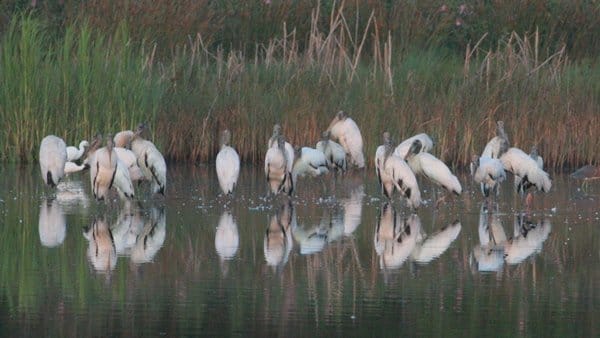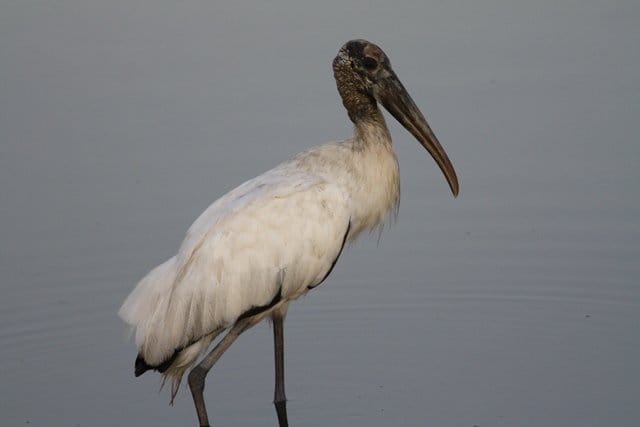European Storks are majestic, they’re graceful and stately and all of the positively connotated adjectives that are applied to birds to which humans have a long and pleasant history rooted deep in our western cultural heritage. In fact, there’s hardly a bird in the world that has such a venerated relationship with us. They are, after all, the feathered bearers of actual children if the old stories are to be believed, and their shadow lies long over birder and non-birder alike. Though they’re scarce across much of central Europe anymore, you can still find the the massive nests they build on the roofs of houses in the eastern part of their historic range and in Iberia, and so great is the nostalgia surrounding them that reintroduction of captive raised birds have been a popular, and mostly successful, venture in many parts of the European continent. They’re beautiful birds, and an example of the way birds and humans can coexist more or less prosperously for centuries.
I mention all of this because we in North America, especially the southern part of North America, have storks too. But ours have none of the cultural cache that European White Storks enjoy in their home range. Where White Storks are beautiful, ours are grotesque. Where they’re urbane and sophisticated, ours seem dour and rural. Where theirs would cradle the next generation carefully swaddled and bill borne, ours would seem more fit to be slumming it with vultures and crows. Of course, I’m speaking of the mysterious Wood Stork, Mycteria americana, the only representative of that famous family to regularly occur north of the Mexican border and present in large numbers along the northern coast of South Carolina, where I found myself a couple weekends back.
It would be difficult to imagine our Wood Storks hauling child, at least one that wouldn’t be screaming, rendered completely terrified by the featherless face than invokes nothing so much as a skinned skull. In fact, so pervasive is the myth of the gentle caring Stork that I suspect few non-birders would even characterize ours as a close relative. They just don’t look it. When faced with a massive flock nearly 100 birds deep, as I did at Huntington Beach State Park recently, the sense is even one of foreboding rather than charm. There’s no two ways about it, they’re ominous, and I count myself as one who really likes Wood Storks.

Wood Storks are an exceptionally old species, and its existence predates the last Ice Age, around 15,000 years ago, by tens of thousands of years more. Fossils discovered in Brazil are indistinguishable from modern Wood Storks, and date from at least the late Pleistocene. This is a bird with some pedigree. That’s only based on the physical evidence, taking into account more circumstantial stuff, the species is probably even older still. Its the only member of the genus Mycteria in the New World, the rest of its cogeners, a handful of other bald and nearly bald Storks with long curved bills, hail from East Africa and South Asia. This begs the question, how did the Wood Stork end up in the Americas with relatives so far away?
Mycteria as a genus dates from the Miocene, at minimum 5 to 7 million years ago. The continents then were more or less as they are today, so the split between Wood Stork and its Asian cousins must have occurred prior to that. The Stork family has roots all the way back to the Paleogene, 40-50 million years ago, and while storks are epic aerialists, capable of covering long distances, an ocean might be too much to ask. In that case perhaps the New World Wood Stork and the other Old World Mycterias are not as closely related as their appearance would suggest, but the question is fascinating though. In any case, with its craggy features and measured movements, it’s easy to believe that this is a visage, homely though it may be, that has been around a while.

Here’s to the Wood Stork, then! It’s no looker, it may not nest on our roofs or transport our progeny, but its story is far more fascinating than any old wives’ tale.













Wood Storks are awesome, seen them in Florida and Belize, but are they really vulturine? I saw the headline and was expecting adjuncts or marabous.
Maybe not quite to the degree of Marabous in that they don’t eat carrion, but they’re about as close as we get in North America.
You are right, Nate: that close-up of the Wood Stork really shows the skull resemblance. I’m fortunate to have seen Marabous (not Wood Storks though) and they look bad-ass, but not skullish.
Interesting, has there been any genetic work done on Mycteria to assess monopholy? I didn’t find much with a quick search….
@Jochen- Marabous are much fleshier than Wood Storks. But Old World Vultures appear to have fleshier heads than the stripped down New World Vultures too. I don’t know what that means. Probably nothing.
@David- I don’t think so, and I was looking for it because when I discovered the Asian Myterines while doing this post, their inclusion in that genus seemed so odd to me. There has to be a common ancestor, at least theoretically, but where could it come from?
I honestly have to admit your subtle suggestion of *Mycteria* species having been separated by continental drift made me facepalm. The rift between the Americas and the Old World took place well in the Cretaceous, long before the likely existence of *Mycteria*, ciconiids and quite likely neornitheans themselves.
The disjunct distribution of *Mycteria* might be remarkable, but it is far from unlikely or extraordinary. Certainly during the Miocene, the world had an overall more hospitable climate than it has today, thus theoretically allowing the climate preferred by modern *Mycteria* species to have existed farther to the north and closer or even up to and including Beringia. This sea-strait was intermittently dry during the Miocene, thus connecting the Americas to Eurasia.
Most likely, Miocene *Mycteria* species (provided they even required the same climate as their modern descendants) simply had a continuous range from Eurasia through Beringia to the Americas. Mind you, *Mycteria* may not have been present in South America yet as the isthmus of Panama may or may not have formed by that time. Even then, overseas dispersal to a still isolated South America may not be all that unlikely.
Probably, the ancestors of the South American jabiru (and indeed the fossil South American marabous known from the Miocene) followed the same route *Mycteria* did. During the Miocene, crowned cranes *Balearica* were also present in North America and throughout Eurasia, even if they are restricted to Africa today. Most likely, these essentially terrestrial birds of open habitats also spread by way of Beringia.
So in conclusion, the disjunct distribution of *Mycteria* is hardly mysterious.
I forgot to add to my previous post that it seems fairly likely for the ice ages to have driven modern *Mycteria* south and causing the extinction of the populations of the genus between the ranges of the modern species. Conceivably, *Mycteria* and even *Balearica* were widespread throughout the northern continents up to the first ice ages, starting in the latest Pliocene epoch.
This would cause the large distance between the ranges of modern *Mycteria* species.
@Brian- I didn’t intend to suggest, even subtly, that Mycteria in Asia and the Americas were split by continental drift. I state that the genus dates to the Miocene, looooong after the continents were connected. Now I may have done that ham-handedly – I’m not a paleontologist – but it was my intention to state that that explanation didn’t hold any water in this case. So, sorry for the lack of clarity.
And thanks much for the explanation. That’s really cool.
Nice post Nate. Super-cool birds and amazing how erratic their breeding success can be from year to year in Florida especially. Anyone know how long-lived they are. I’ve heard up to 30 years in captivity but doubt it would be that long in the wild?
Thank you for the interesting article about storks and for the informative commentary.
In California, we have fossils (quite numerous) of a Marabou-like stork. Also, the California Condor is said to be a relative of the Marabou Stork.
Vulturine Storks aren’t grotesque-looking, although some of their eating habits are certainly unappealing.
It would be interesting to know more about both the extant vulturine storks and extinct ones.
@Nate, sorry for apparently misreading what you were trying to say.
@Eric: Concerning that Californian ‘marabou-like stork’, you’re probably referring to *Ciconia maltha*, the so-called Asphalt Stork. It might interest you to know that this ecological claim about this stork is solely based on what amounts to speculation by Alan Feduccia (and perhaps Storrs Olson). The soft anatomy of *C. maltha* is unknown and *Ciconia* storks in general are not particularly marabou-like, so the basis for claiming the bird to have been like a marabou in habits is just its association with the La Brea tar pits and its bountiful supply of carrion.
Needless to say, that’s a very shaky basis. The La Brea tar pits also include the likes of turkeys, grebes and ducks as well as numerous mammalian herbivores, so the association between *all* tar pit victims and carrion-eating is unfounded. *C. maltha* may have been marabou-like, but as far as I know there is no solid evidence for that.
Also, it’s worth noting that marabou storks do not scavenge nearly as much as wildlife documentaries and popular knowledge would have you believe. Marabous scavenge when the opportunity arises, but will normally hunt whatever small and edible creatures they encounter, much like ‘typical’ storks do. Marabous can be fairly formidal predators in their own right however, as they are known to kill adult flamingos.
As for condors…the idea that New World vultures (which include condors) are close to storks was in voque in the 90’s but is nowadays considered incorrect. Unfortunately, this does not seem to have reached popular science very much and the refuted theory is still regularly displayed by people who, ironically, want to show how up to date they are concerning avian classification. Rather than being storks or closely related to them, it would seem that cathartids (as New World vultures and condors are called) are what they were thought to be in the past: an ancient lineage of birds of prey most closely (albeit only fairly distantly) related to a clade consisting of the secretary bird, the osprey and typical accipitrids (hawks, eagles, kites, Old World vultures and so on). You could include all of them in a single order Accipitriformes or seperate cathartids into their own order Cathartiformes. In the end, nomenclature is arbritary. Do not that falcons (Falconidae) are not generally considered close to any of these nowadays. Therefore, the traditional order Falconiformes would be invalid for a clade that only includes cathartids, saggittariids, pandionids and accipitrids (or any of them).
were the Ciconia Maltha (Asphalt Stork)related to the ciconia maguari in south america or the Ciconia Boyciana? I’m wondering how much is known about them? were they the same size as modern storks? did they have migrations?
Brian. Can you point us to the newer DNA evidence refuting the New World Vulture Stork relationship?